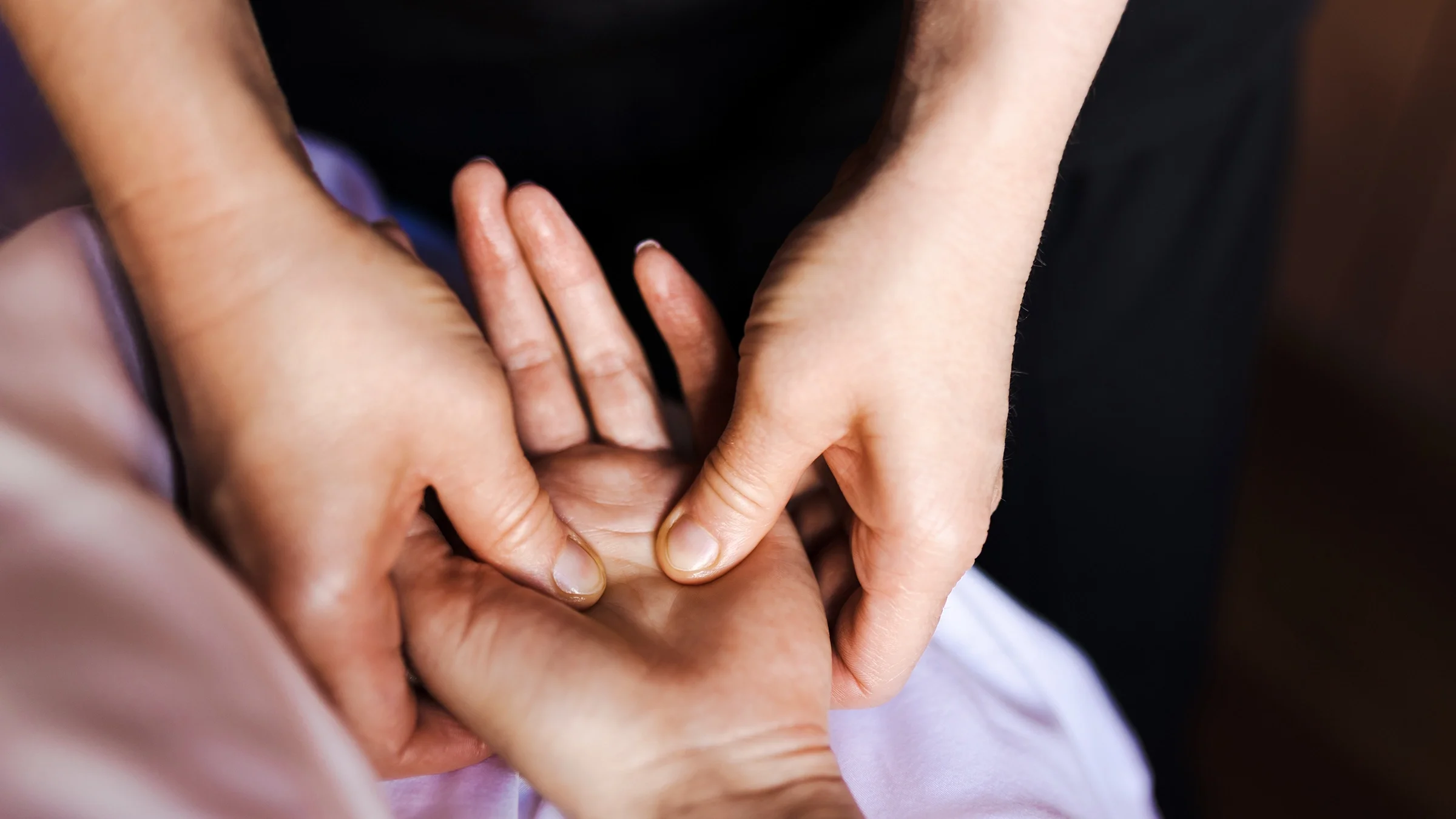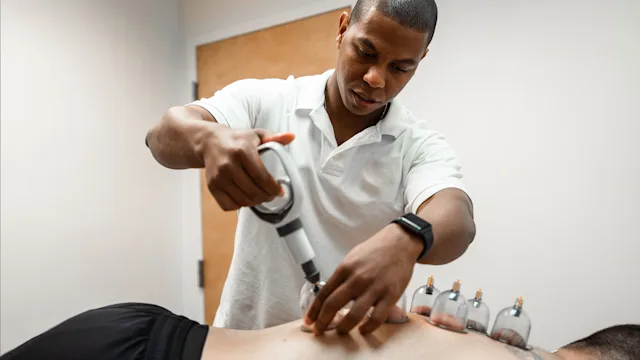Key takeaways:
Acupressure is one of the focal treatment methods used in traditional Chinese Medicine.
Research around this ancient form of massage is limited. However, some initial findings suggest it can help alleviate pain and discomfort caused by a host of conditions.
You don’t need to go to a special place to get acupressure; you can perform it in the comfort of your home. But be sure to talk with a healthcare provider if you’re pregnant or have underlying health conditions.
If you’re looking for a holistic approach to alleviating pain associated with menstrual cramps, arthritis, or even certain gastrointestinal disorders, consider acupressure.
“Acupressure is a practice that involves putting pressure on strategic points throughout the body that are also acupuncture points,” Laura Purdy, MD, told GoodRx Health. “But, instead of needles, acupressure involves applying some force to the area for a certain duration [of time] and is designed to relieve symptoms associated with that particular point.”
How effective is acupressure?
Overall, the research around the benefits of acupressure is lacking. But that doesn’t necessarily mean that acupressure isn’t effective.
Search and compare options
As is the case with any form of treatment, whether alternative or conventional, the results largely depend on the individual. Some people may find more relief than others.
How does acupressure differ from acupuncture?
There are many similarities between acupressure and acupuncture. But one stark difference is that acupuncture involves needles, whereas acupressure does not.
“Acupressure is the pressing and stimulation of acupuncture points without piercing the skin,” licensed acupuncturist Tsao-Lin Moy, MSOM, told GoodRx Health.
“Acupuncture is a complete system of medicine that originated in China thousands of years ago,” licensed acupuncturist Itorye Silver, DAOM, told GoodRx Health. And the practice has long been proven to be an effective form of therapeutic intervention, she added.
“Acupuncture uses specific points on the body to alleviate suffering and sustain health. The locations of these points were discovered through observation of the ill or wounded, by noting tender spots along the body,” Silver said.
These specific points on the body are known as acupoints. “[They] may be stimulated using pressure — called acupressure — or by inserting hair-thin needles, called acupuncture,” Silver said.
Read more like this
Explore these related articles, suggested for readers like you.
Both acupressure and acupuncture can help restore balance in the body by lowering inflammation and improving circulation, she noted.
What does acupressure treat?
Rather than as a treatment for specific conditions, acupressure is best viewed as a means to reduce chronic pain, temporary discomfort, and general stress.
“Acupressure is more so used to ease symptoms such as headache, nausea, stress, and aches and pains throughout the body,” Purdy said. “It’s generally not designed to cure or completely resolve specific diseases as a whole. But it can be really beneficial in alleviating symptoms that people have.”
Moy suggested that acupressure can treat pain caused by certain conditions by increasing blood flow to an area and “stimulating the release of feel good-chemicals,” known as endorphins.
What pressure points does acupressure target?
According to experts, there are pressure points all over the body that can help alleviate a host of symptoms — for a variety of conditions.
“These points would be depressed (held) for 3 to 5 minutes with sustained pressure, or treated with heat,” Silver said, describing a typical acupressure session. The symptoms associated with the activated pressure points should subside during the session, she added.
Here are four common pressure points and how they might help alleviate symptoms.

1. Yintang: Might help combat sinus pressure
“There’s a point between the eyebrows that, when pressure is applied, may relieve sinus pain, pressure, or congestion,” Purdy said.
2. Neiguan (PC6): Might relieve indigestion and anxiety
“There is a point on the palm side of the wrist, 2 to 3 inches from the crease of the wrist, in the middle of the arm,” Purdy said. “Pressing on that may help with acid reflux, indigestion, nausea, or anxiety.”
3. Taichong (Liv3): Might alleviate pain associated with headaches and PMS symptoms
Purdy explained that there is a particular acupoint in the space where the bone in the big toe and the second toe meet. Applying pressure here might alleviate some premenstrual symptoms including:
Headaches
Pain from menstrual cramps
Anxiety
4. Zusanli: Might promote healthy bowel movements
“Another useful point is [located] right below the knee, on the outside of the kneecap,” Purdy said. “Placing pressure here may result in relief of vomiting, diarrhea, or constipation.”
Potential benefits of acupressure
The existing research on acupressure is limited and mainly comes from smaller studies. But the findings show that it might help ease symptoms of several unique conditions, as well as general ones.
“The studies that have been done so far do seem to suggest that it is clinically, significantly beneficial for conditions such as pain and anxiety,” Purdy said, adding that more research is needed to help the medical community understand acupressure’s benefits.
A few of these potential benefits include reduced:
Symptoms that commonly accompany vertigo
Are there side effects to acupressure?
The research does not appear to suggest there are any adverse reactions associated with acupressure or acupuncture. In fact, the findings of several studies would suggest there are more benefits associated with the ancient practice than possible pitfalls.
“At this point, and with the research that is available, it does appear that acupressure is a great complementary and alternative therapy,” Purdy said.
Though, it’s normal to feel slight pain or discomfort as pressure is being applied to the acupoint. It’s even normal to feel soreness afterward.
Can you do acupressure on yourself?
Yes, you can, in fact, do acupressure on yourself.
“There’s no specialized training required,” Purdy said. “You can find charts, guides, and examples online that help you understand how to do it at home.”
There are even special acupressure mats you can purchase. These have plastic spikes on them that put pressure on different acupoints.
“When applying acupressure, try to relax and breathe deeply as you massage the area,” Silver said.
Do’s and don’ts for acupressure
“Acupressure is generally considered to be very safe and does not require specialized training to do,” said Purdy. “It is very unlikely that you will cause harm or worsen any symptoms or conditions by attempting acupressure at home.”
That said, it goes without saying that it’s not wise to engage in any practice that causes intense pain. Here are some other, general rules of thumb to keep in mind about at-home acupressure, according to Purdy and other experts.
Do’s
Consult your healthcare provider if you experience pain while doing acupressure.
Apply moderate pressure to the acupoint until symptoms absolve.
Don’ts
Do not do acupressure if you have an active infection or open wounds or sores in the area where you’d apply pressure. This could worsen the infection or disrupt healing.
Since the evidence around using acupressure during pregnancy is lacking, it’s safest to talk with a healthcare provider first.
Do not perform acupressure on top of varicose veins.
If you have any underlying conditions or injuries, make sure you speak to your healthcare provider before attempting acupressure.
The bottom line
Acupressure is an alternative therapeutic approach that is generally considered safe for most people. While the scientific research on acupressure is limited, the ancient practice may help relieve pain and minor health issues. However, if you’re pregnant or have underlying health conditions, talk with your care team first before trying acupressure at home.

Why trust our experts?



References
Alessandrini, M., et al. (2012). P6 acupressure effectiveness on acute vertiginous patients: A double blind randomized study. Journal of Alternative and Complementary Medicine.
Allais, G., et al. (2012). Acupressure in the control of migraine-associated nausea. Neurological Sciences.
Bazarganipour, F. (2017). The effect of applying pressure to the LIV3 and LI4 on the symptoms of premenstrual syndrome: A randomized clinical trial. Complementary Therapies in Medicine.
Chen, S., et al. (2022). Effects of acupressure on anxiety: A systematic review and meta-analysis. Journal of Integrative and Complementary Medicine.
Chen, Y., et al. (2013). The effectiveness of acupressure on relieving pain: A systematic review. Pain Management Nursing.
Hjelmstedt, A., et al. (2010). Acupressure to reduce labor pain: A randomized controlled trial. Acta Obstetricia et Gynecologica Scandinavica.
Hseih, L. L., et al. (2010). Effect of acupressure and trigger points in treating headache: A randomized controlled trial. The American Journal of Chinese Medicine.
Li, L. W., et al. (2017). Self-acupressure for older adults with symptomatic knee osteoarthritis: A randomized controlled trial. Arthritis Care & Research.
Monson, E., et al. (2019). Beyond pills: Acupressure impact on self-rated pain and anxiety scores. Journal of Alternative and Complementary Medicine
Murphy, S. L., et al. (2019). Self-administered acupressure for chronic low back pain: A randomized controlled pilot trial. Pain Medicine.
ScienceDirect. (n.d.). Zusanli.
University of Michigan Rogel Cancer Center. (n.d.). Acupressure.
Van Hal, M., et al. (2022). Acupuncture. StatPearls.

















